The stunning cave in Antiparos is a must-see! Here is some information on the wonderful Antiparos cave in the Cyclades Greece. Includes opening hours and ticket prices.
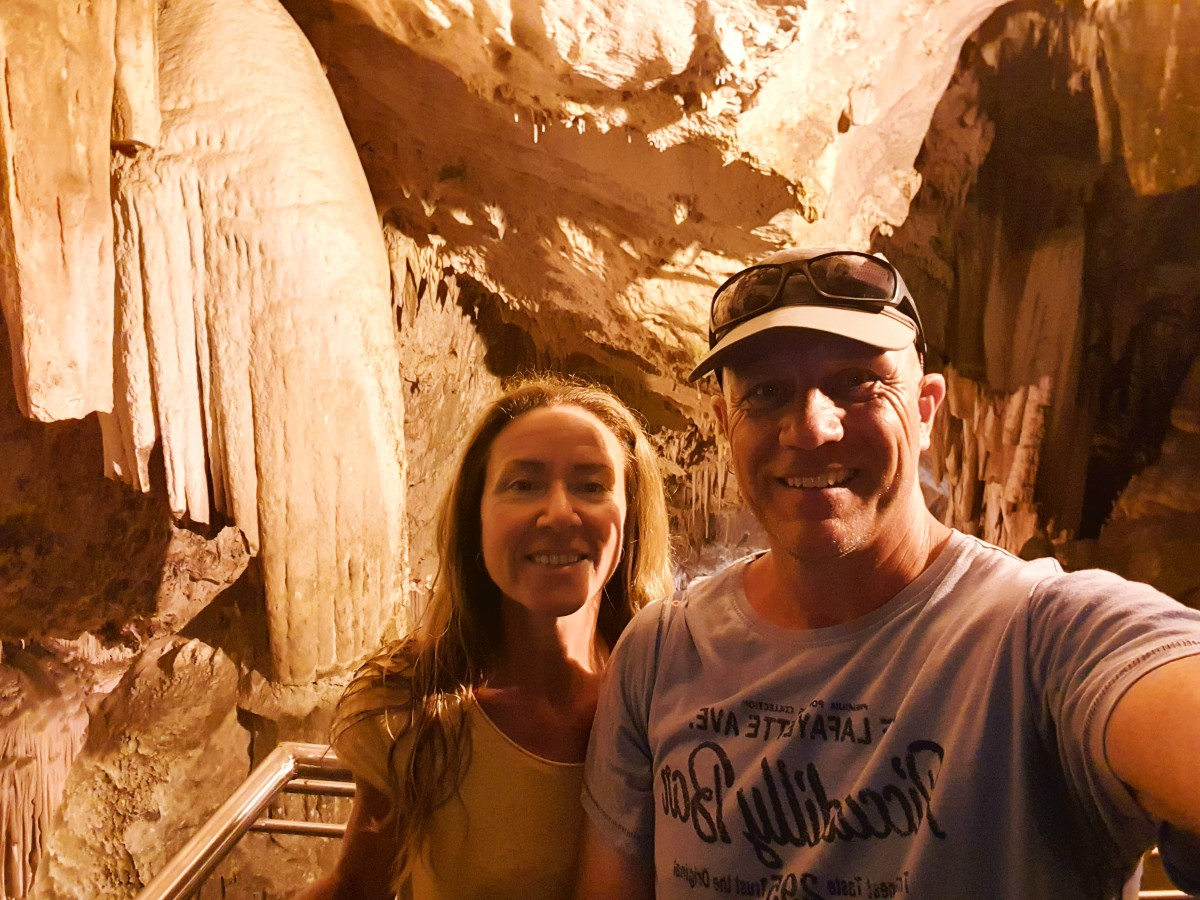
The Cave in the Greek island of Antiparos
There are hundreds of caves all around Greece. These natural wonders, with the magnificent stalactites and stalagmites, have always attracted people’s interest.
Since the paleolithic ages, many of them have been used as dwellings, shelters, tombs or even places of worship. They have always fascinated visitors, speleologists, and archaeologists.
One of the best-known caves in Greece is on the island of Antiparos, which is one of the Cyclades islands. If you haven’t been to Greece before, here’s an introduction to the Greek islands.
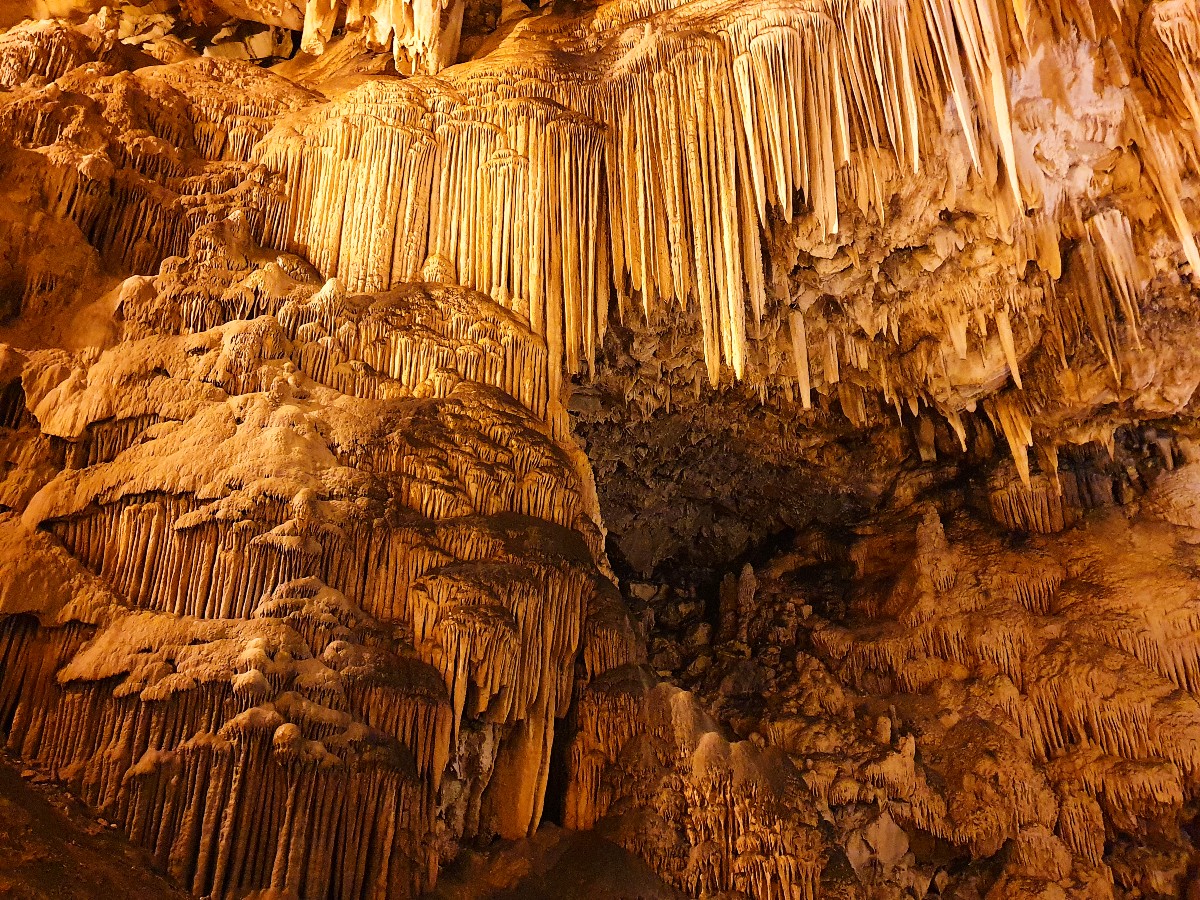
The Antiparos cave is the number one attraction on the small island. It was one of our highlights for our month-long trip to the Cyclades last summer!
I had actually visited twice before, so I kind of knew what to expect. However, the infrastructure when I last visited was old, and more slippery.

Here is some information on the amazing cave in Antiparos.
History of the Antiparos Cave
The Antiparos cave has been known since antiquity. It was originally used as a shelter, and there is evidence that it also served as a place of worship for Goddess Artemis, one of the 12 Olympian Gods.
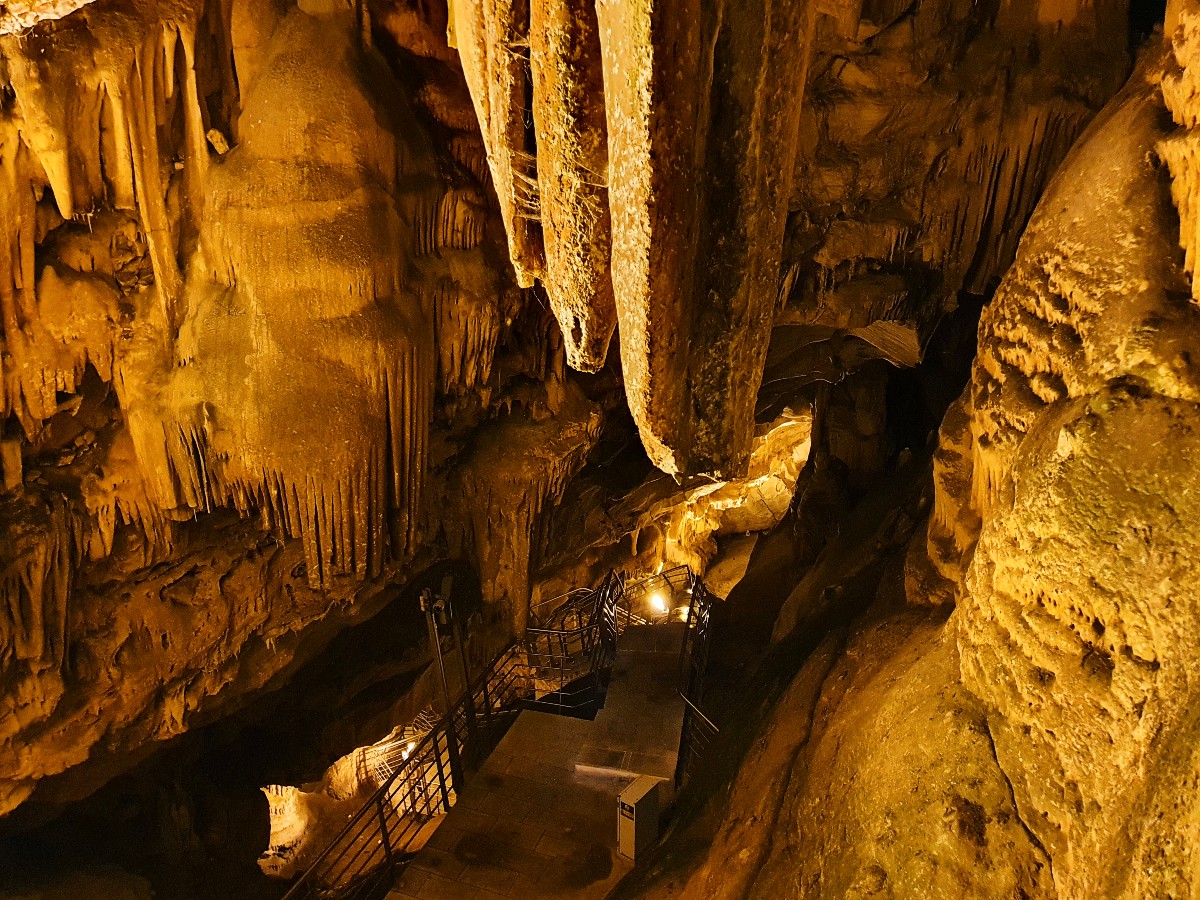
Thousands of people have lived or visited here over the last millennia. Findings include fragments of ancient vases, some of which are exhibited in the Archaeological Museum in Paros.
In the past few centuries, many of the stalactites and stalagmites were removed from the cave. Some of them were taken to France in 1673, when a certain Marquis de Nointel visited the cave with his entourage.
During the Russian occupation in Paros and Antiparos, between 1770 and 1774, the Cave was further destroyed. Some of the stalactites and stalagmites removed during that era can be seen at the Hermitage Museum, St Petersburg.
Finally, during WWII, more stalactites and stalagmites were detached by the German conquerors.
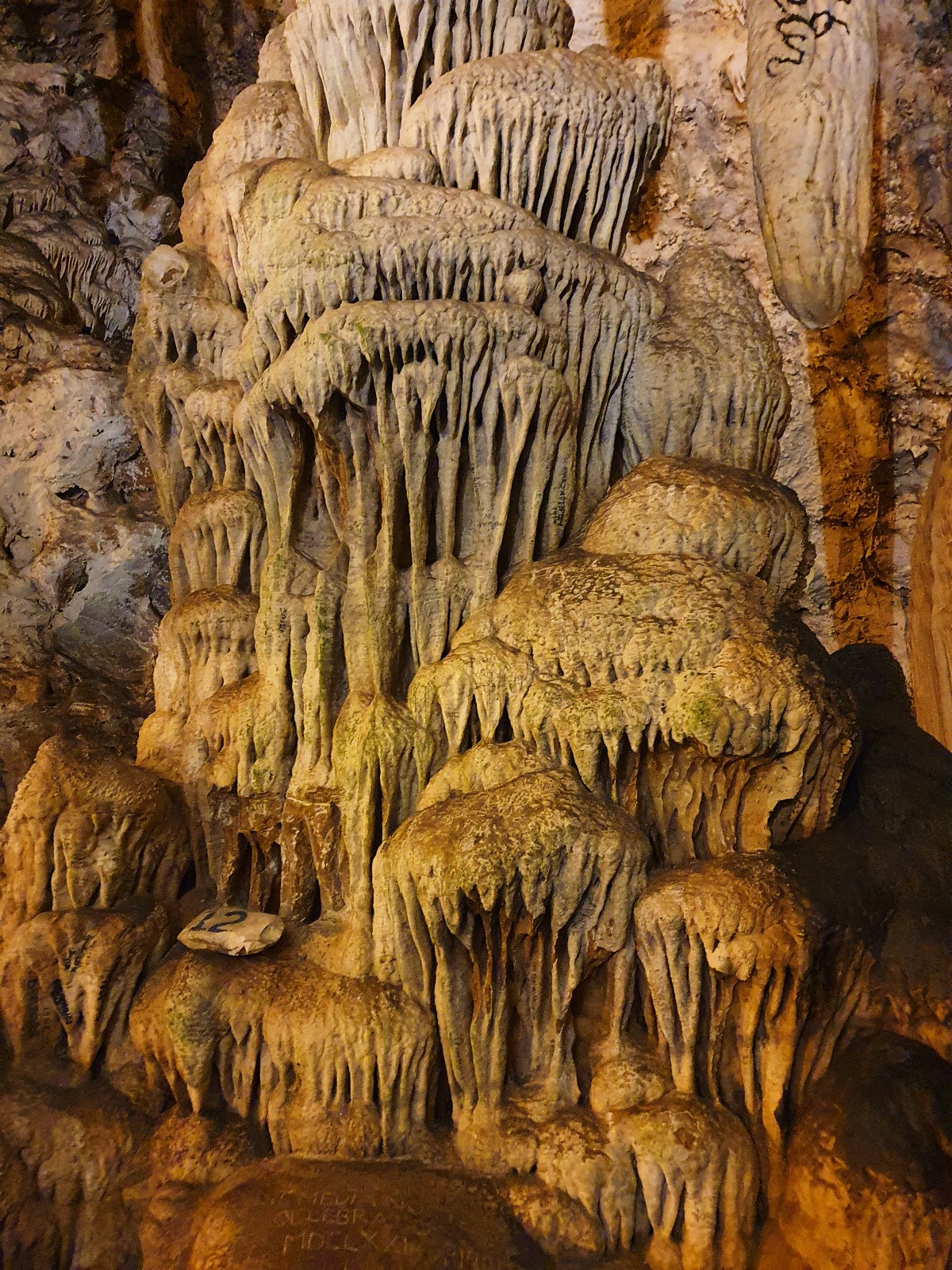
As stalactites grow at an average rate of about 1 cm per 100 years, it would take millions of years for them to be repaired. Still, there are many interesting natural formations inside the cave.
Depending on your imagination, they may resemble various familiar objects.
Inside Antiparos Cave – Carvings and signatures
While the natural beauty of the cave is impressive, another thing which will amaze visitors are the writings on the walls of the cave, proof of all these people who have visited.
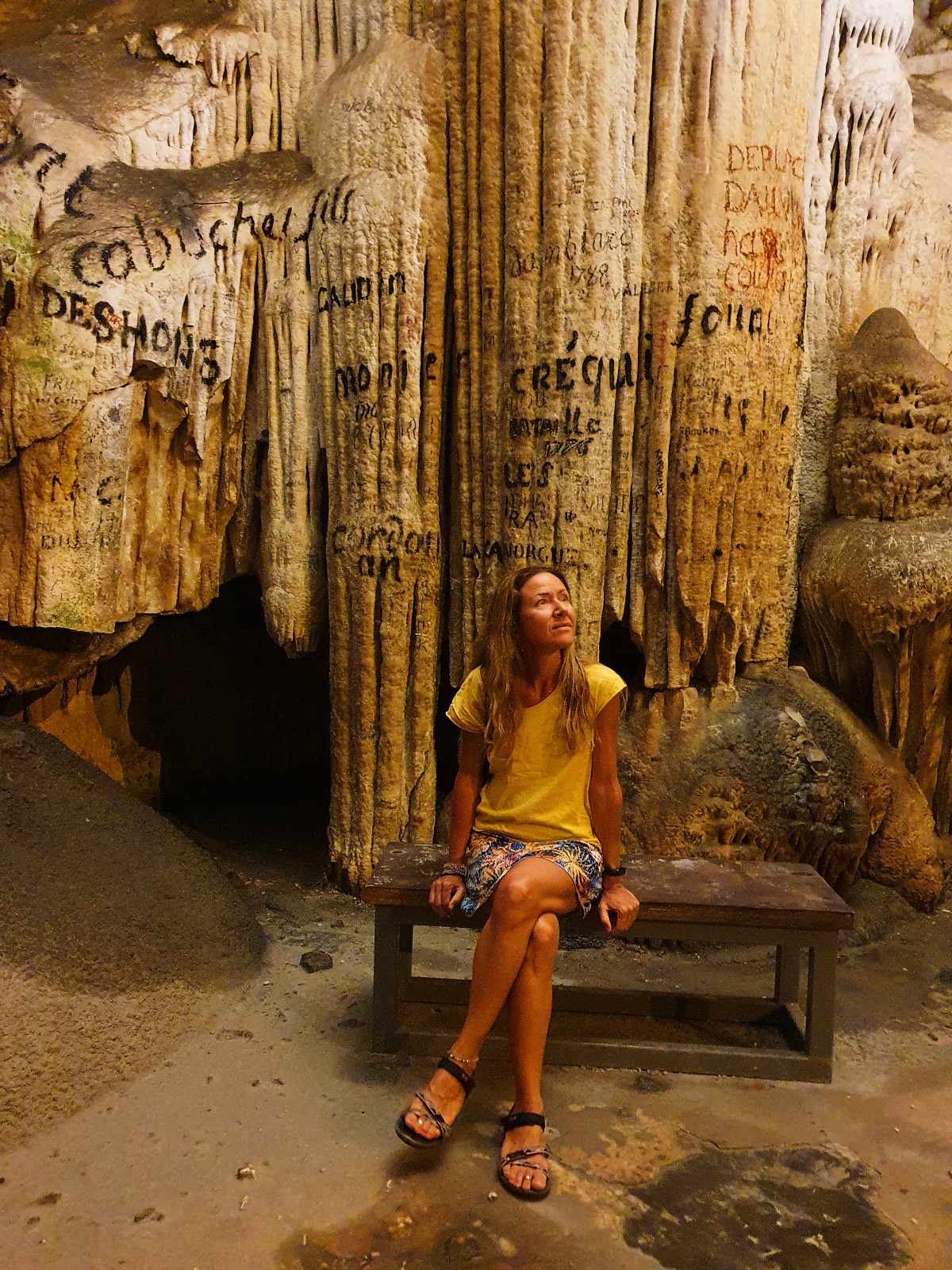
It is said that certain Macedonian generals found shelter here during the 4th century BC, after conspiring against Alexander the Great. The sign with their names by the entrance of the cave has reportedly survived since that era.
Whether any of this is true or a legend, is not certain, but it’s an interesting story nonetheless!
Below, you can see a 1673 carving, when the Marquis de Nointel and his followers held a Christmas Mass in the Antiparos Cave.
Apparently, this sign translates into “Christ himself was here and celebrated the day of His birth at midnight in 1673”. It’s a shame he had to take with him all these souvenirs… I guess at the time you couldn’t actually buy any Greek souvenirs!
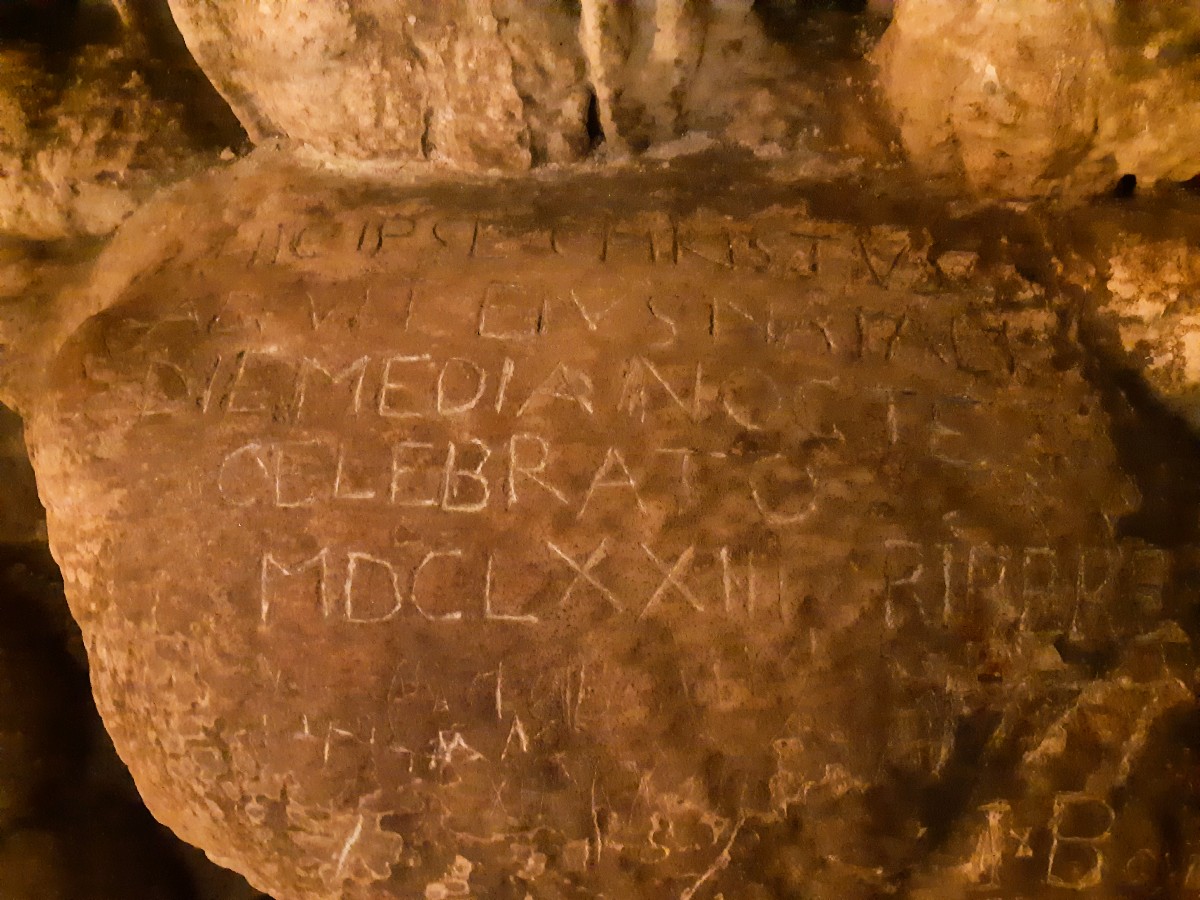
Here, you can see King Otto’s signature, who visited with his wife Amalia in 1840. Queen Amalia was the person who designed the National Gardens in Athens.

Lord Byron, the poet who wrote about the Greek Revolution in 1821, has also visited the cave. Unfortunately, we couldn’t locate his signature anywhere.
Instead, here is someone called H. C. Cadisch. I couldn’t find any info about him, but I loved his calligraphy.
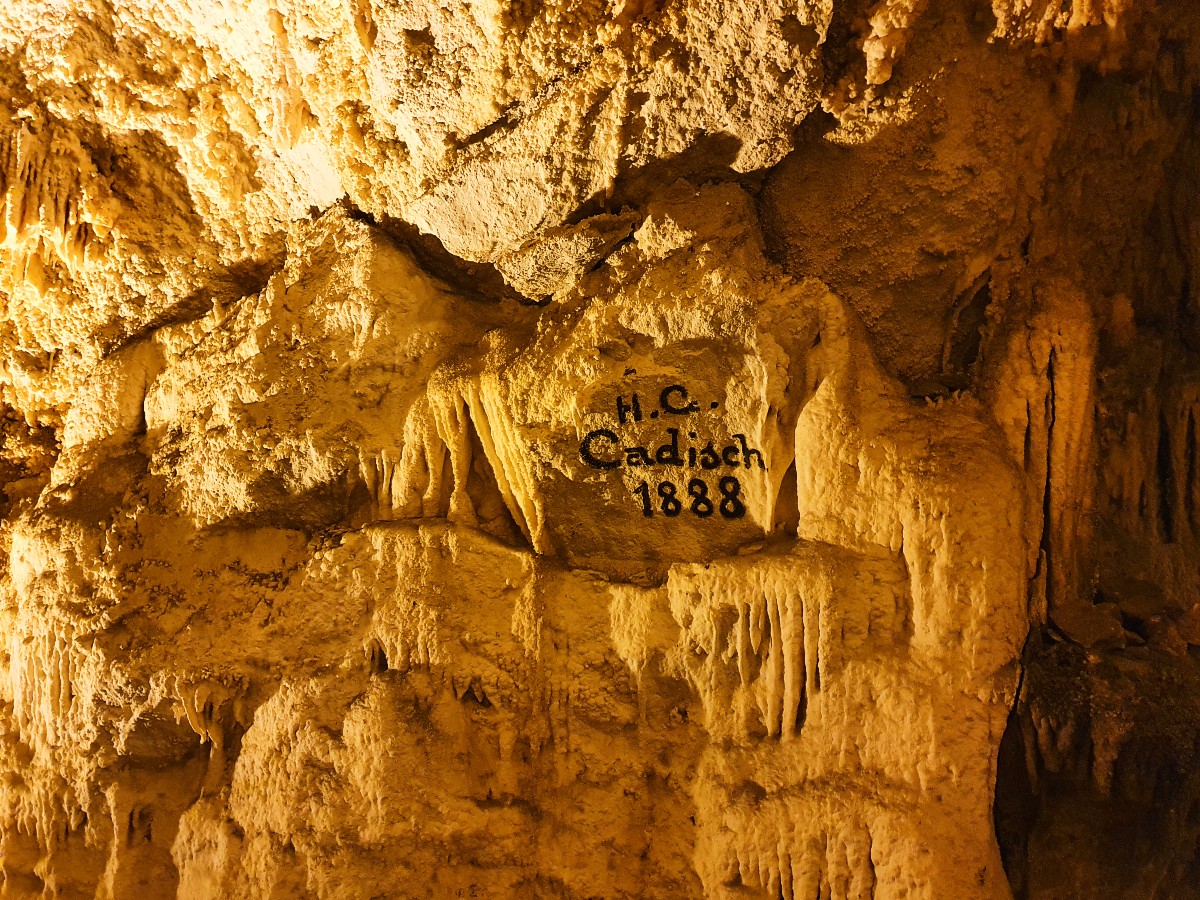
I thought that all those signatures were pretty cool. In my opinion, they are an inherent part of the cave, and one of the reasons why it’s so special!
A few facts about the cave in Antiparos
And now, here are a few facts about the cave in Antiparos.
The Antiparos cave is the only vertical cave in Europe, and extends at several levels.
There are four main rooms, which all have names. These names were chosen by the prominent speleologist Anna Petroheilou who designed the original touristic route inside the cave in 1979, when she was 74 years old.
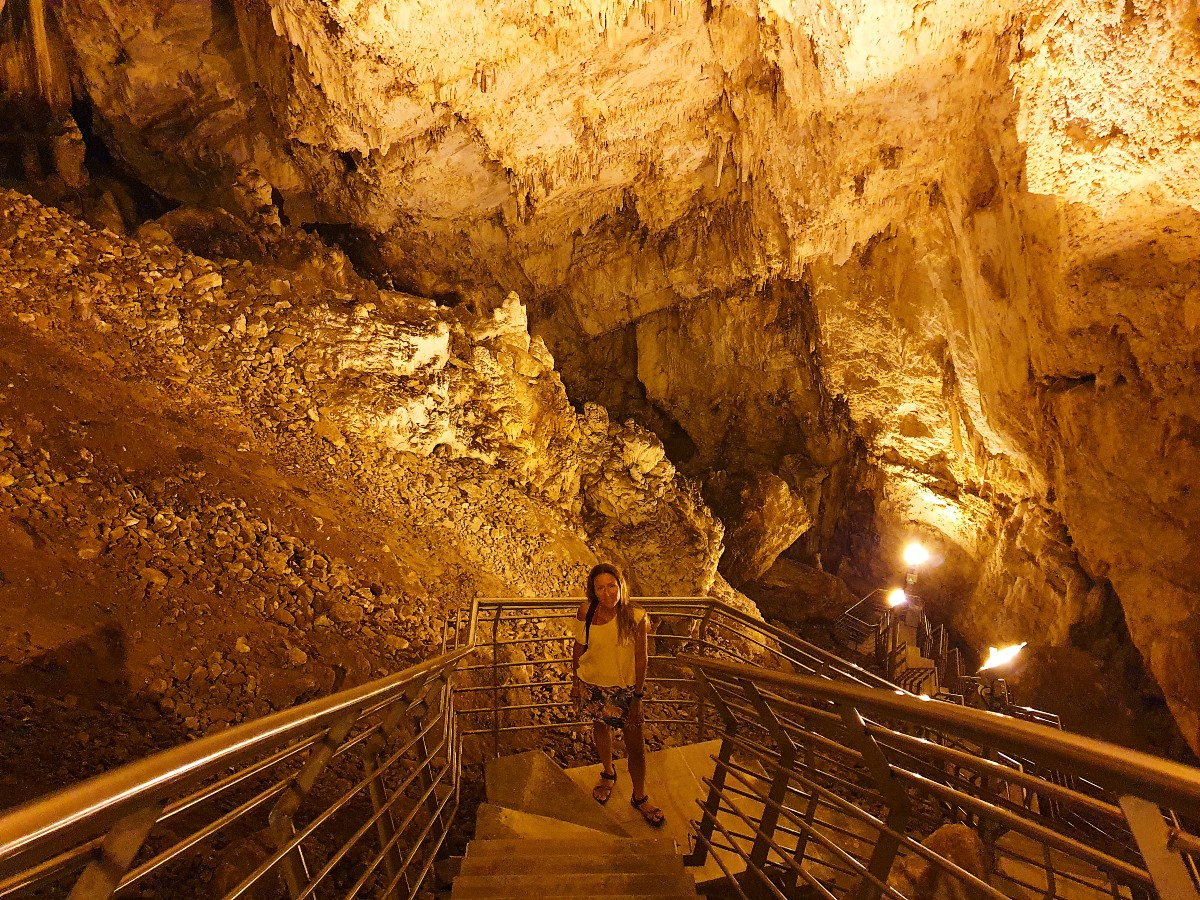
(Side note: This woman was amazing – she was the first Greek woman to climb mount Olympus, in 1930, and has explored over 1,000 caves worldwide!!
One of her famous quotes was “I’ve spent most of my life underground. When I die, it’s not going to make a special impression”. She died in 2001, at age 96).
The stalactite at the entrance of Antiparos cave is the oldest in Europe. According to estimates, it is 45 million years old!
The cave entrance is at an altitude of 171 metres, and its depth is approximately 85 meters. There is a modern, steepish staircase with a metal handrail, going all the way down. Apparently there are 411 steps, but we didn’t count them 😊

Just a quick note: the staircase was installed in 2009 and replaced the old facilities. In some places, parts of the staircase almost dig into the stalactites and stalagmites. Installing it must have been a massive technical challenge.
At the entrance of the cave, you will see the small church of St John Spiliotis. Greeks use the name Agios Ioannis Spiliotis, or Ai Yiannis Spiliotis.
The church celebrates annually on 7 – 8 May, and there is a feast with local food and wine.

How to get to Antiparos Cave
If you have your own vehicle, you can easily reach the Antiparos cave by road from Antiparos town. It’s a short 10 – 15 minute drive, and there is parking space with fantastic views of Antiparos just underneath the cave. Here’s some more info on driving in Greece.
If you are feeling active, you can also walk or cycle there from the town. It’s an easy 7 km trail, passing by Prophet Ilias church and a few other chapels.

Alternatively, you can take a bus from Antiparos town. Bus itineraries vary by time of year, so check out the posters at Antiparos port and this website.
Antiparos Cave opening hours, tickets and other info
Adult tickets for Antiparos cave cost 5 euro. There is also a combined ticket including the Historical and Folklore Museum in Antiparos town, for 6 euro. There are discounts for children under 12 years old.
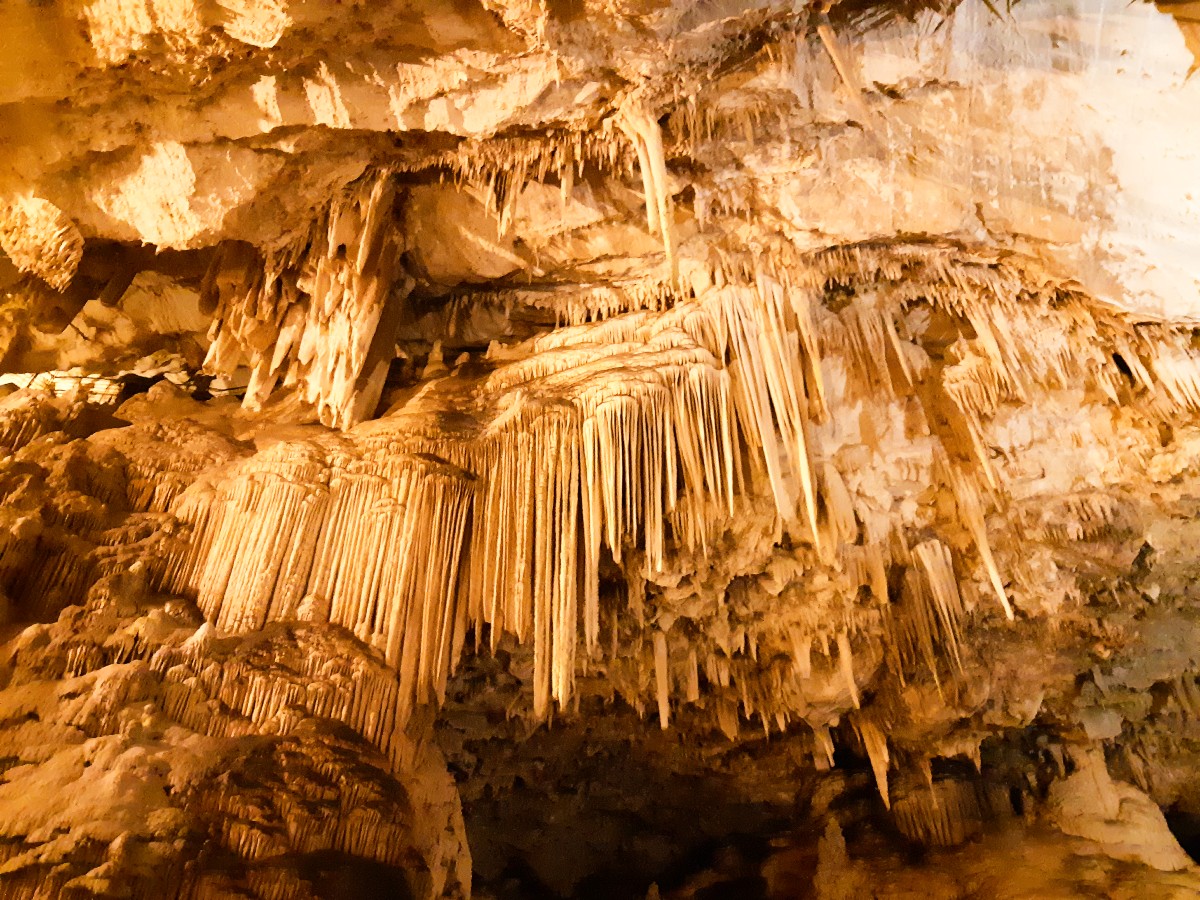
Antiparos cave opening hours are from 10.00 to 16.00. The Historical and Folklore Museum in the town is usually open in the evenings.
The temperature inside the cave is quite low – they say it’s 15 degrees in winter, but I thought it was higher than that. We found it very pleasant after the 30+ outdoors temperatures!
Although the cement staircase is easy to walk on, it’s best to have comfortable, non-slippery shoes.
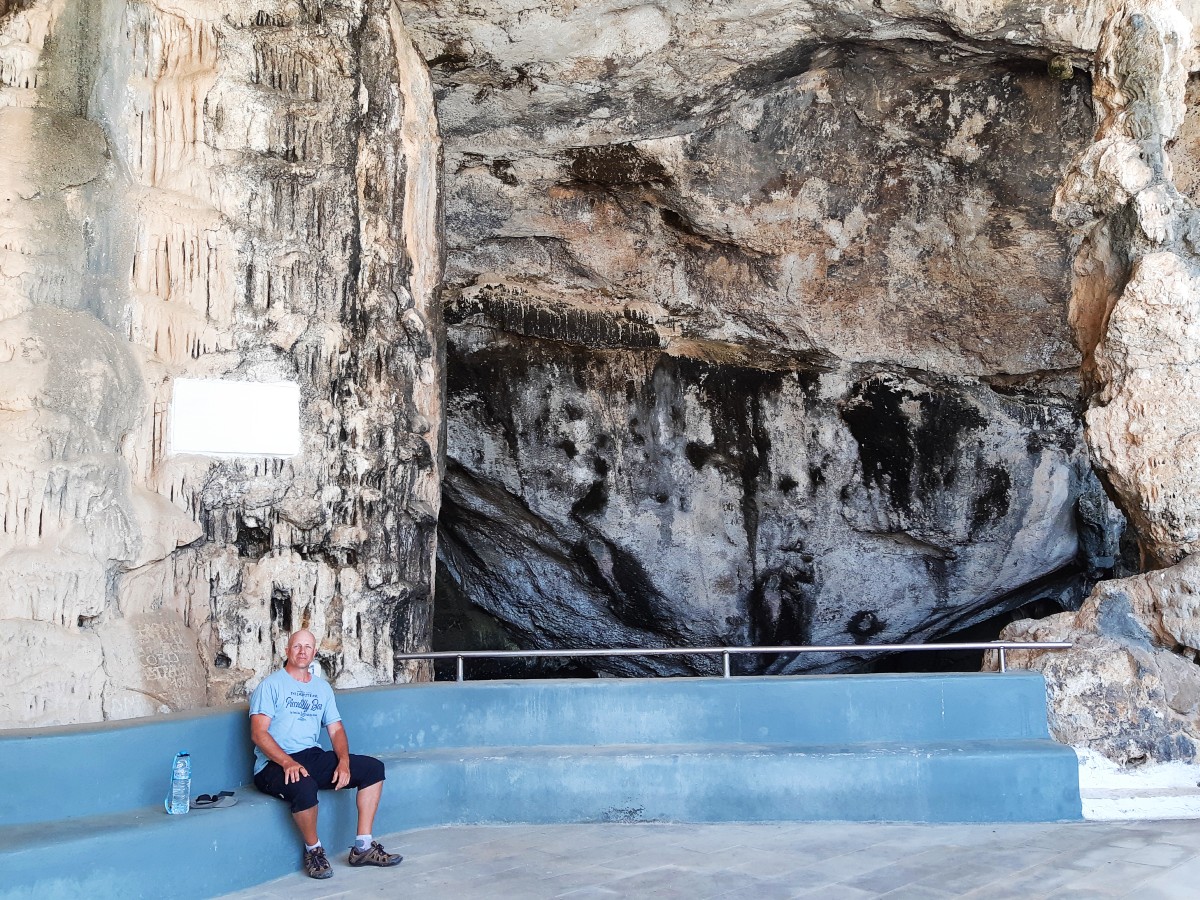
Because of the high levels of humidity, going up the 411 steps can be a little tiring. People with a heart condition or respiratory problems might want to avoid visiting.
As expected, breaking off stalactites and stalagmites or writing anywhere on the cave’s surfaces is strictly prohibited these days.
Photography is allowed, with no flash. Allow at least an hour to see the cave properly and take all the photos you want!

Last tip – There are toilets right outside the cave, but nowhere to buy water or anything else. Bring a bottle, as you will need it after all these stairs!
How to get to Antiparos in Greece
Antiparos is the only inhabited Cycladic island apart from Thirasia which is not directly connected with any of the ferry ports in Athens. Unless you are on your own sailing boat, the only way to get there is by a quick ferry ride from Paros island.
You can get to Paros on a ferry from Piraeus or Rafina port in Athens, and there are several ferries per day. I use Ferryscanner to check and book ferry tickets to the islands and back.
There are two types of ferries running between Paros and Antiparos, none of which can be booked online.
A small passenger ferry leaves a few times a day from the main Paros port, Parikia. Departure times tend to change frequently, so check out the posters at the port for the latest information.
You can get your ticket, which costs 5 euro, right outside the boat. The trip lasts about a half hour.

In addition, a passenger / car ferry departs from Pounta port, on the west coast of Paros. These ferries depart every half hour, and again you get your ticket on the ferry.
They only cost 1.20 euro, whereas a quad and a small car costs 4 / 6.70 euro respectively. This ferry ride takes only 7 minutes – just about enough to take a few photos of the ports!

Note – You can easily visit the cave and explore Antiparos town on a day trip from Paros. I recommend staying longer though, as Antiparos might grow on you.
Other caves to visit in Greece
While the cave in Antiparos is one of the most iconic caves in Greece, there are many, many more. The island of Crete alone is said to have over a thousand caves!
Many of the caves in Greece have been explored, but they are not officially open to the public, so you can visit them at your own risk. A great example is the cave of St John in Iraklia – you literally need to crawl to enter.
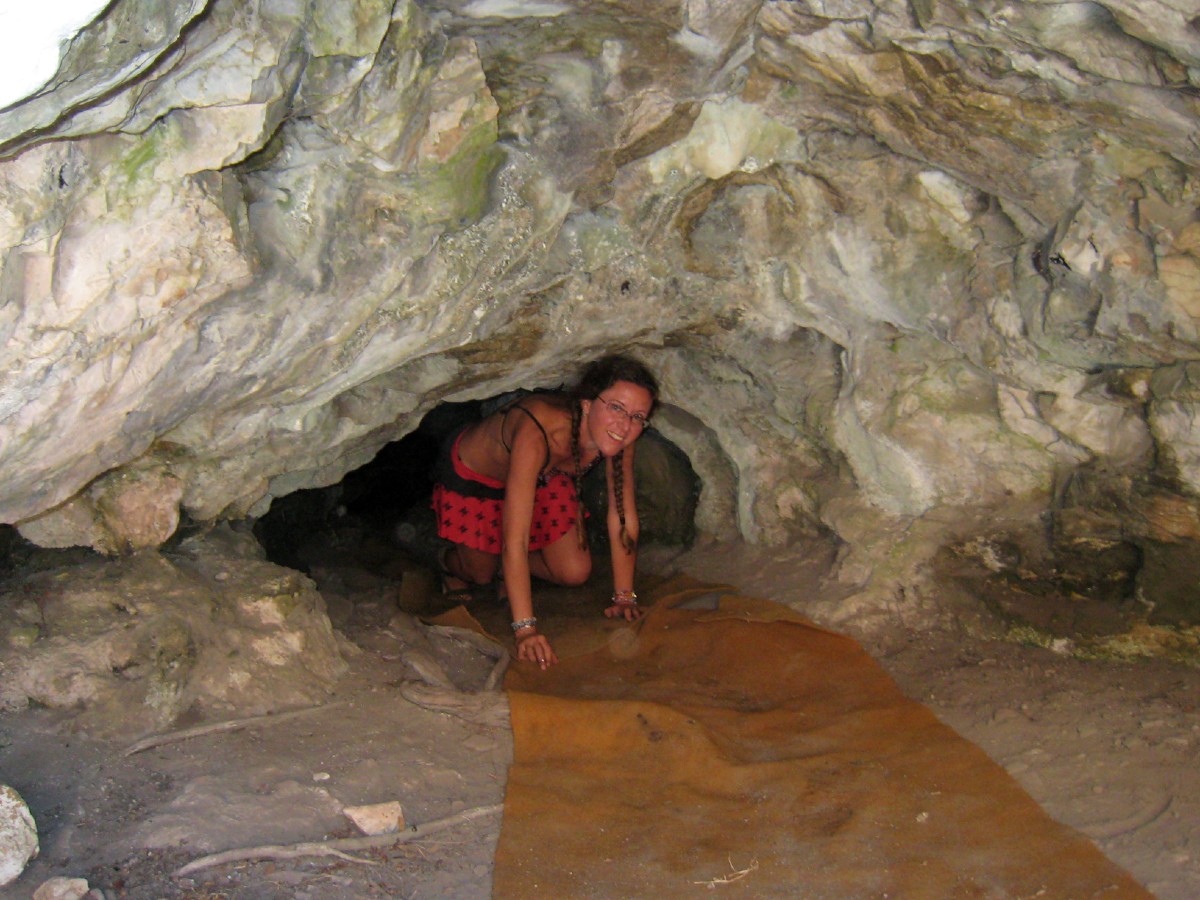
In others, facilities have been installed so that people can explore them with safety. Here are some of the best-known caves in Greece that you can visit for a small entrance fee:
- The caves of Diros in Laconia (Peloponnese)
- Frachthi / Franchthi cave in Argolida (Peloponnese)
- Dikteon cave in Lassithi (Crete)
- Theopetra cave near Meteora (Thessaly)
- The Petralona cave in Chalkidiki
- Caves of Melissani and Drogarati in Kefalonia.
There are dozens more, so before you travel to Greece, check whether there are any caves close to the areas you are going to!
Have you been to the Cave of Antiparos?
If you’ve been to the Antiparos cave, what did you think? Let me know in the comments!
Here are a couple more things to do in Antiparos:
 Hi! I am Vanessa, a travel writer from Athens. I love exploring the Greek islands, and the cave in Antiparos is one of my favourite places! If you have any questions, post them right below, or get in touch on the Real Greek Experiences FB page and FB group.
Hi! I am Vanessa, a travel writer from Athens. I love exploring the Greek islands, and the cave in Antiparos is one of my favourite places! If you have any questions, post them right below, or get in touch on the Real Greek Experiences FB page and FB group.
